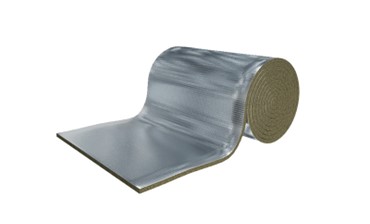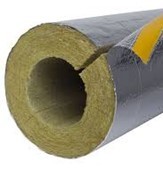First of all, what is foil-faced rock fibre insulation?
When we refer to foil-faced rock fibre, we’re talking about products that contain a rock fibre core of a particular density wrapped in an aluminium foil outer. This can either be supplied in preformed cylinder lengths or as a roll.
Why is foil-faced rock fibre insulation mentioned?


Our standard installation details typically mention foil-faced rock fibre insulation for two reasons. The first reason is that there is an insulated metal pipe application where we have conducted testing of our products against foil-faced rock fibre of certain thicknesses and densities.
There are many types of insulation in terms of densities. For instance, looking at QB-FW100-D-11 in detail, the first type of insulation is a 25mm-thick foil-faced glass wool or rock fibre, which has a minimum density of 30kg/m³.

The second type of insulation is a 25mm-thick foil-faced insulation with a minimum density of 120kg/m³. Finally, in the row below, the same thickness foil-faced rock fibre is used again but with just 90kg/m³ this time.
The second reason for the use of foil-faced rock fibre is for services with metal components. Foil-faced rock fibre is installed as part of the fire-resistance seal to help prevent the spread of heat and achieve an Insulation (I) fire-resistance rating.
If we look at the details of QB-FW100-D-02 (page one), it’s a double-batt detail for cables and cable trays. The fire ratings are achieved based on the sole use of the QuelStop HPE Sealant around the services.

The second page of this detail requires the addition of a foil-faced rock fibre insulation. This then enhances the fire rating to EI 120.

While you can achieve an integrity rating with just HPE sealant, additional insulation will be needed to slow the spread of heat. So, in the case of this detail, we’re looking at a 40mm-thick foil-faced rock fibre insulation that must be installed 300mm on both sides of the seal. This is why it is essential to identify the most appropriate standard installation detail and pay attention to the different types of insulation referenced on the detail drawing. Ultimately, the various types and thicknesses of insulation will change the outcome of the fire rating.
Is a particular brand of insulation recommended?
The simple answer is no, you’re not limited to a brand, but you are limited to the specification. This is why we use the terminology on our details to specify the thickness or minimum thickness and density required.
A minimum density of 90kg/m³ would cover brands like PAROC AluCoat T, which has a density of 90kg/m³, and Rocklap H&V, which is typically 120kg/m³. Both these brands could be considered for the appropriate Quelfire standard installation details.
Is it important to know what’s required at an early stage?
For several reasons, it is vital to identify the requirements of foil-faced rock fibre at the design stage rather than trying to find solutions during the build. Some reasons are:
-
To meet fire-resistance requirements
For high insulation ratings, a certain density or thickness may be required that the MEP designers have not included. -
Affecting service performance
Cable carriers with cables may require the use of foil-faced rock fibre to achieve the required fire-resistance rating. MEP designers need to be made aware of this early, as this can impact the selected cables. -
Cost
If not considered at early stages, budgets for passive fire protection are likely to be incorrect as firestopping installers may not have priced the application with the inclusion of foil-faced rock fibre. -
Service spacing
Including additional foil-faced rock fibre may impact service spacing that may not have been considered at the design stage.
It is then essential that the MEP designers provide specific and correct information at an early stage to ensure the correct Quelfire detail can be selected to meet the project’s requirements.
Always check prior to build, and, if in doubt, contact us. We’re here to support you!
We now supply Foil-faced Rockfibre Ductwrap (QFFDW); learn more about its features and benefits today.

